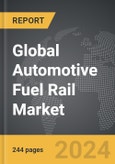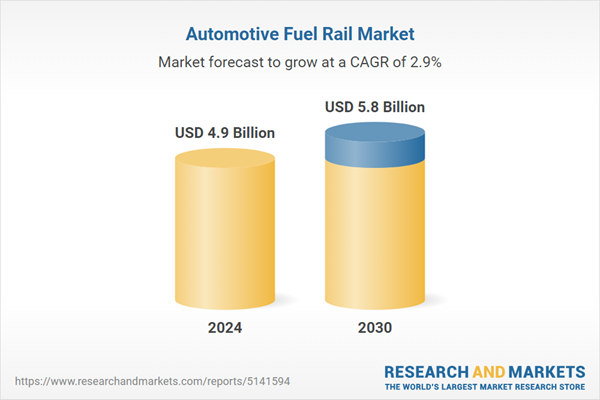Global Automotive Fuel Rail Market - Key Trends & Drivers Summarized
Why Is the Automotive Fuel Rail Market Gaining Momentum?
The automotive fuel rail market is witnessing substantial growth, driven largely by the ongoing evolution of internal combustion engines (ICE) towards improved efficiency and reduced emissions. Fuel rails, which are critical for delivering fuel to the engine's injectors under precise pressure, play an essential role in achieving optimal combustion and enhanced fuel economy. As emission norms grow stricter globally, particularly in regions like Europe and North America, automakers are increasingly focusing on advanced fuel delivery systems that enhance combustion efficiency while reducing emissions. The integration of direct fuel injection systems in both petrol and diesel engines has been instrumental in boosting the demand for high-performance fuel rails, capable of maintaining consistent fuel pressure under variable conditions.How Are Technological Developments Shaping the Automotive Fuel Rail Landscape?
Technological advancements have significantly impacted the automotive fuel rail market, with a focus on optimizing material use, increasing durability, and improving performance under extreme conditions. Fuel rails are now being manufactured using materials such as stainless steel and high-strength aluminum alloys, which provide resistance to corrosion, high temperatures, and pressures, thereby extending the lifespan of these components. Furthermore, the trend towards direct injection technology, which requires higher fuel pressure, has led to the development of advanced fuel rails designed to withstand and regulate these pressures more effectively. In hybrid vehicles, fuel rails are also being designed to support both electric and combustion modes seamlessly, providing efficient fuel management for varied power demands.What Role Does Consumer Preference Play in Fuel Rail Adoption?
Changing consumer preferences for more fuel-efficient and eco-friendly vehicles are impacting the automotive fuel rail market as well. Consumers are demanding vehicles that offer both performance and lower carbon footprints, putting pressure on automakers to enhance the efficiency of their combustion engines. This has translated into greater adoption of direct and port fuel injection systems, which rely on advanced fuel rails for precise fuel delivery. Additionally, the trend towards turbocharging and downsizing of engines to meet emission regulations without compromising power is also increasing the need for advanced fuel rail systems capable of maintaining high pressure and providing consistent fuel flow, ensuring optimal engine performance across different load conditions.The Growth in the Automotive Fuel Rail Market Is Driven by Several Factors.
The adoption of stringent emission regulations globally is one of the primary drivers of the automotive fuel rail market, as it compels automakers to optimize fuel delivery and combustion processes. The rising popularity of direct fuel injection systems in both petrol and diesel engines, which require higher and more stable fuel pressures, is further contributing to market growth. Additionally, the growing trend of engine downsizing, combined with turbocharging, necessitates the use of high-quality fuel rails capable of delivering efficient fuel flow. Investments in new materials that provide durability and resistance to corrosion and temperature extremes are also driving innovation in fuel rail systems. Lastly, the expansion of the hybrid vehicle market, which demands sophisticated fuel management, continues to boost the demand for advanced fuel rails, as they must support both combustion and electric modes effectively.Report Scope
The report analyzes the Automotive Fuel Rail market, presented in terms of market value (USD Thousand). The analysis covers the key segments and geographic regions outlined below.Segments
Application (Gasoline Engine, Diesel engine); Engine Type (V-Engine, Inline Engine); Material Type (Acrylic, Fiberglass, ABS Plastic, Other Material Types); Vehicle Type (Passenger cars, Commercial vehicles, Electric Vehicles).Geographic Regions/Countries
World; United States; Canada; Japan; China; Europe (France; Germany; Italy; United Kingdom; Spain; Russia; and Rest of Europe); Asia-Pacific (Australia; India; South Korea; and Rest of Asia-Pacific); Latin America (Argentina; Brazil; Mexico; and Rest of Latin America); Middle East (Iran; Israel; Saudi Arabia; United Arab Emirates; and Rest of Middle East); and Africa.Key Insights:
- Market Growth: Understand the significant growth trajectory of the Gasoline Engine Application segment, which is expected to reach $3.7 Billion by 2030 with a CAGR of a 3.4%. The Diesel Engine Application segment is also set to grow at 2% CAGR over the analysis period.
- Regional Analysis: Gain insights into the U.S. market, valued at $1.3 Billion in 2024, and China, forecasted to grow at an impressive 5.2% CAGR to reach $1.2 Billion by 2030. Discover growth trends in other key regions, including Japan, Canada, Germany, and the Asia-Pacific.
Report Features:
- Comprehensive Market Data: Independent analysis of annual sales and market forecasts in USD from 2024 to 2030.
- In-Depth Regional Analysis: Detailed insights into key markets, including the U.S., China, Japan, Canada, Europe, Asia-Pacific, Latin America, Middle East, and Africa.
- Company Profiles: Coverage of major players such as Aisin Seiki Co., Ltd., Aptiv PLC, Autoliv, Inc., Continental AG, Cooper-Standard Holdings Inc. and more.
- Complimentary Updates: Receive free report updates for one year to keep you informed of the latest market developments.
Why You Should Buy This Report:
- Detailed Market Analysis: Access a thorough analysis of the Global Automotive Fuel Rail Market, covering all major geographic regions and market segments.
- Competitive Insights: Get an overview of the competitive landscape, including the market presence of major players across different geographies.
- Future Trends and Drivers: Understand the key trends and drivers shaping the future of the Global Automotive Fuel Rail Market.
- Actionable Insights: Benefit from actionable insights that can help you identify new revenue opportunities and make strategic business decisions.
Key Questions Answered:
- How is the Global Automotive Fuel Rail Market expected to evolve by 2030?
- What are the main drivers and restraints affecting the market?
- Which market segments will grow the most over the forecast period?
- How will market shares for different regions and segments change by 2030?
- Who are the leading players in the market, and what are their prospects?
Some of the 42 major companies featured in this Automotive Fuel Rail market report include:
- Aisin Seiki Co., Ltd.
- Aptiv PLC
- Autoliv, Inc.
- Continental AG
- Cooper-Standard Holdings Inc.
- Denso Corporation
- Keihin Corporation
- Landi Renzo SpA
- Linamar Corporation
- Mitsubishi Electric Corporation
- Robert Bosch GmbH
- Standard Motor Products, Inc.
- TI Fluid Systems Plc
- Usui Co. Ltd.
Table of Contents
Companies Mentioned (Partial List)
A selection of companies mentioned in this report includes, but is not limited to:
- Aisin Seiki Co., Ltd.
- Aptiv PLC
- Autoliv, Inc.
- Continental AG
- Cooper-Standard Holdings Inc.
- Denso Corporation
- Keihin Corporation
- Landi Renzo SpA
- Linamar Corporation
- Mitsubishi Electric Corporation
- Robert Bosch GmbH
- Standard Motor Products, Inc.
- TI Fluid Systems Plc
- Usui Co. Ltd.
Table Information
| Report Attribute | Details |
|---|---|
| No. of Pages | 244 |
| Published | April 2025 |
| Forecast Period | 2024 - 2030 |
| Estimated Market Value ( USD | $ 4.9 Billion |
| Forecasted Market Value ( USD | $ 5.8 Billion |
| Compound Annual Growth Rate | 2.9% |
| Regions Covered | Global |









